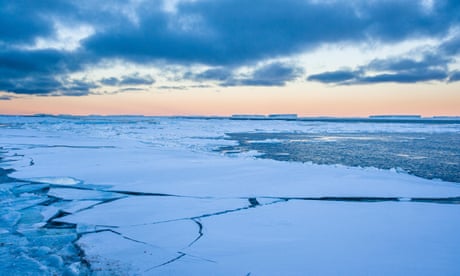I'm just an ordinary OAP trying to 'Save the World' for my Granchildren before I kick the bucket or, dare I say, I just give in and say 'FUCKIT'!!
Monday, February 27, 2023
3 Just Stop Oil supporters released after 109 days in prison without trial!
Sunday, February 26, 2023
YET ANOTHER RECORD BROKEN? Earliest Spring on Record in North America!
Parts of US see earliest spring conditions on record: ‘Climate change playing out in real time’
Parts of Texas, Arkansas, Ohio and Maryland, along with New York, are all recording their earliest spring conditions on record
Blooming daffodils in New York City. Leaves sprouting from red maples in North Carolina. Cherry blossoms about to bud in Washington. Record winter warmth across much of the eastern US has caused spring-like conditions to arrive earlier than ever previously recorded in several places, provoking delight over the mild weather and despair over the unfolding climate crisis.
In New York, one of several US cities to experience its warmest January on record, spring conditions have arrived 32 days before the long-term normal, which is its earliest onset of biological spring in 40 years of charting seasonal trends by the National Phenology Network.
Spring activity has, meanwhile, arrived at least 20 days earlier than usual for huge swathes of the US south-east and east, with parts of central Texas, south-east Arkansas, southern Ohio and Maryland, along with New York, all recording their earliest spring conditions on record so far this year.
“It’s a little unsettling, it’s certainly something that is out of the bounds of when we’d normally expect spring,” said Teresa Crimmins, director of the National Phenology Network and an environmental scientist at the University of Arizona. “It perhaps isn’t surprising, given the trajectory our planet is on, but it is surprising when you live through it.”
Saturday, February 25, 2023
King Charles has co-written a children's book about Climate Change and the Environment!
On Friday the King hosted global leaders at Buckingham Palace to support action on restoring the natural world.
Speaking at the reception, the book's co-author Chair of Natural England Tony Juniper said the King wanted to empower young people.
"I think he's been struck by the level of energy and passion shown by young people on these subjects, and was keen to put something into their hands which was about those basic facts and figures, basic ideas, but also with his personal message in there," Mr Juniper said.
In 2017 the King and Mr Juniper wrote a book for adults about climate change. The new publication aims to make the topic accessible for 7-11 year-olds and is "trying to bring the facts to the fingertips of the people who've got most to gain by finding solutions in time," Mr Juniper explained.
Leaders from government, business, charities and indigenous communities went to the palace reception to support stronger action on protecting biodiversity.
It followed promises made by nations at the UN summit COP15 in December to prevent what is called the "sixth mass extinction event". Biodiversity - the variety of living things - is declining faster than at any time in human history.
In the historic deal known as the Global Biodiversity Framework, almost 200 countries pledged to protect 30% of the planet by 2030 to allow nature to flourish.
The King's reception followed a major government meeting aimed at kick-starting private fundraising to deliver on promises made at the UN's COP15 summit in December.
Environment Secretary Thérèse Coffey said the meeting was aimed at mobilising private finance to meet goals set at COP15.
"Instead of constantly playing catch-up and repairing the damage that's subsequently happened, which can cost even more money, let's get solutions now," Ms Coffey told BBC News.
In recognition of their role as protectors of the natural world, indigenous leaders from the Amazon also met King Charles at Buckingham Palace. One placed a necklace of seeds around the King's neck.
"We want the King to be an intermediary for our people with the other countries," said Amazon leader Domingo Peas.
Biodiversity is in crisis across the globe - half of coral reefs have disappeared and scientists say 75% of the Earth's surface is degraded. Between 2001 and 2021 the world lost 437 million hectares of tree cover.
Human activity plays a big role on this. In 2019, a United Nations report said that harvesting, logging, hunting and fishing are causing overexploitation, of animals, plants and other organisms.
The UK is one of most nature-depleted nations in the world, according to experts.
No river in England can be given a clean bill of health from chemicals, sewage and other pollutants released into waterways.
Government efforts to improve England's environment have also been called inadequate by the independent Office for Environmental Protection (OEP).
In January the government released a plan to protect rare wildlife and clean up land and water over the next five years.
King Charles has spent much of his life campaigning to protect the environment. In November he hosted a reception to discuss tackling climate change ahead of the UN COP27 summit in Egypt.
Wednesday, February 22, 2023
Food Insecurity is already here but sadly this is only just the beginning!
Tuesday, February 21, 2023
Stronger El Nino events may speed up irreversible melting of Antarctic sea ice!
Stronger El Niño events due to global heating may accelerate irreversible melting of the Antarctic ice sheet and ice shelves and the rise in sea levels, according to research from Australia’s premier government science agency.
Previous studies have found that rising atmospheric greenhouse gas concentrations are expected to increase the magnitude of the El Niño Southern Oscillation (Enso), the planet’s most significant year-to-year climate fluctuation and a major driver of extreme droughts and floods. Extreme warm El Niño events and cool La Niña events are expected to become more frequent as the planet heats.
Relatively little has been known about the impact of Enso changes in Antarctica. A new study published this week in the journal Nature Climate Change led by CSIRO researchers found stronger El Niño events were likely to have divergent impacts in the ocean surrounding the southern continent.
The examination of 31 climate models found stronger El Niños may accelerate the heating of deeper ocean waters while slowing the pace of warming on the surface as westerly winds along the continental shelf become less intense.
The chief research scientist at CSIRO and the study’s lead author, Dr Wenju Cai, said the former would lead to the ice sheet and ice shelves melting faster. The study did not look at how much more rapidly melting may occur.
The Antarctic ice sheet is estimated to contain about 30m cubic kilometres of ice, enough to raise the global sea level by 70m over centuries if completely melted. A separate recent study estimated that global temperatures 1C above pre-industrial levels – a point already passed – would be enough to gradually collapse the West Antarctic ice sheet, leading to four metres of sea level rise.
Sign up for Guardian Australia’s free morning and afternoon email newsletters for your daily news roundup
“This new research shows that stronger El Niños may speed up warming of deep waters in the Antarctic shelf, making ice shelves and ice sheets melt faster,” Cai said. “Our modelling also revealed that warming around the edges of floating sea ice is slowed during this process, slowing down the melting of sea ice near the surface.”
Cai said the results suggested stronger El Niños could have a “double whammy” effect as it would lead to worsening extreme weather – heat, drought and bushfire risk in eastern Australia and floods in California, Peru and Chile – and accelerate sea level rise, causing more extreme coastal inundation.
Dr Ariaan Purich, from Monash University’s School of Earth Atmosphere and Environment and a report co-author, said the results could have broad implications for the global climate system.
“Continuing to understand how Enso will respond to climate change is a critical area of climate research,” she said. “There is still a lot more we need to understand about processes influencing shelf temperatures, and the finding is an important piece of the puzzle.”
Monday, February 20, 2023
Saturday, February 18, 2023
UK Science Museum relies on funding from a company that is destroying the planet!
The Science Museum in London signed a sponsorship contract containing a gagging clause with the Norwegian oil and gas company Equinor, agreeing to take care not to say anything that could damage the firm’s reputation, it can be revealed.
The agreement, a copy of which was obtained by the Guardian and the investigative journalism organisation Point Source, concerned sponsorship of the museum’s current Wonderlab exhibition.
It stated that the Science Museum and its trustees must take reasonable care to “not at any time” during the exhibition term “make any statement or issue any publicity or otherwise be involved in any conduct or matter that may reasonably be foreseen as discrediting or damaging the goodwill or reputation of the sponsor”.
The inclusion of the so-called non-disparagement clause has led to accusations of greenwashing from environmental groups.
Equinor was known as Statoil until it changed its name in 2018. This month it was accused of “profiteering” from the energy crisis and higher household bills after posting record annual earnings of £62bn.
During the fourth quarter of 2022 it produced the equivalent of 2,046m barrels of oil a day. It has oil and gas assets in the North Sea, Brazil, Algeria, Angola, Nigeria and Tanzania.
Equinor and the Science Museum declined to reveal how much the oil company paid to sponsor the Wonderlab exhibition.
Environmental groups claim the Science Museum has lost its ability to honestly discuss the true impact of the oil and gas sector on the environment because of gagging clauses it has signed with big businesses.
In 2021, two prominent scientists refused to allow their work to be included in the Science Museum’s collection after it was revealed that the institution had signed a similar contract with Shell.
Steve and Dee Allen, global plastic pollution researchers, say the museum’s deals with fossil fuel companies such as Shell and Equinor mean it is no longer a credible scientific institution.
Taken from Guardian Newspaper
Friday, February 17, 2023
Arctic Ice disappearing fast!
Antarctica sea-ice hits new record low
- Published
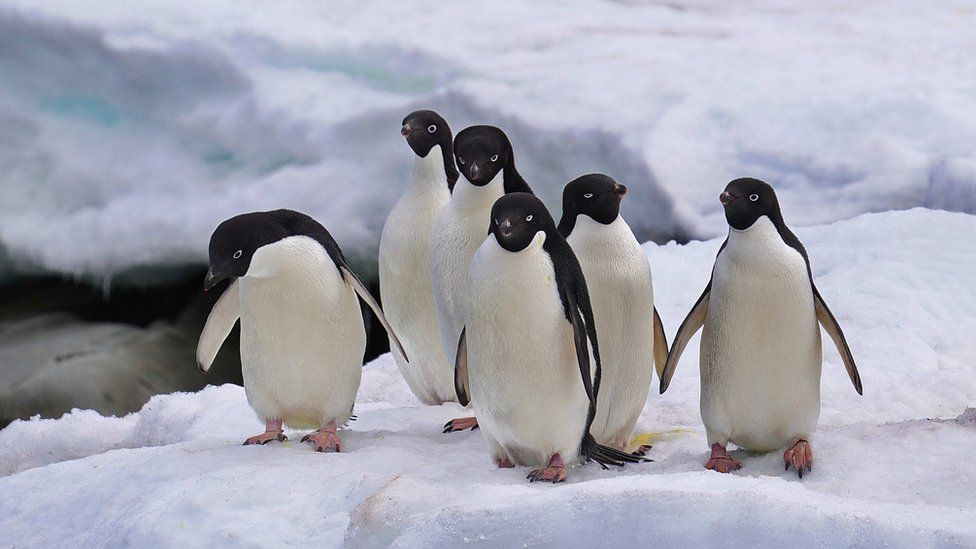
There is now less sea-ice surrounding the Antarctic continent than at any time since we began using satellites to measure it in the late 1970s.
It is the southern hemisphere summer, when you'd expect less sea-ice, but this year is exceptional, according to the National Snow and Ice Data Center.
Winds and warmer air and water reduced coverage to just 1.91 million square km (737,000 sq miles) on 13 February.
What is more, the melt still has some way to go this summer.
Last year, the previous record-breaking minimum of 1.92 million sq km (741,000 sq miles) wasn't reached until 25 February.
Three of the last record-breaking years for low sea-ice have happened in the past seven years: 2017, 2022 and now 2023.
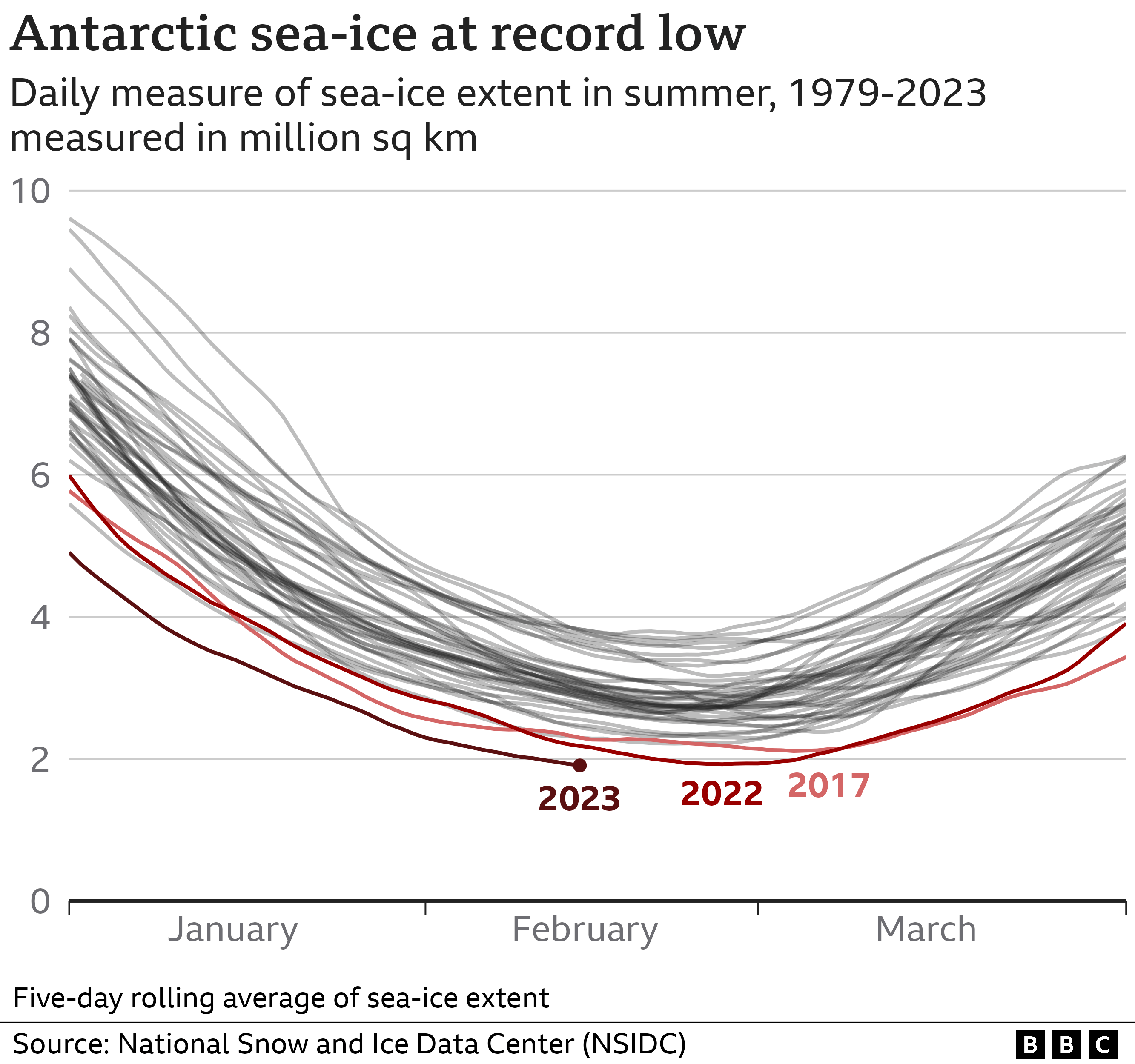
Research, cruise and fishing vessels are all reporting a similar picture as they make passage around the continent: most sectors are virtually ice-free.
Only the Weddell Sea remains dominated by frozen floes.
How unusual is this new record?
Scientists consider the behaviour of Antarctic sea-ice to be a complicated phenomenon which cannot simply be ascribed to climate change.
Looking at the data from the last 40-odd years of available satellite data, the sea-ice extent shows great variability. A downward trend to smaller and smaller amounts of summer ice is only visible in the past few years.
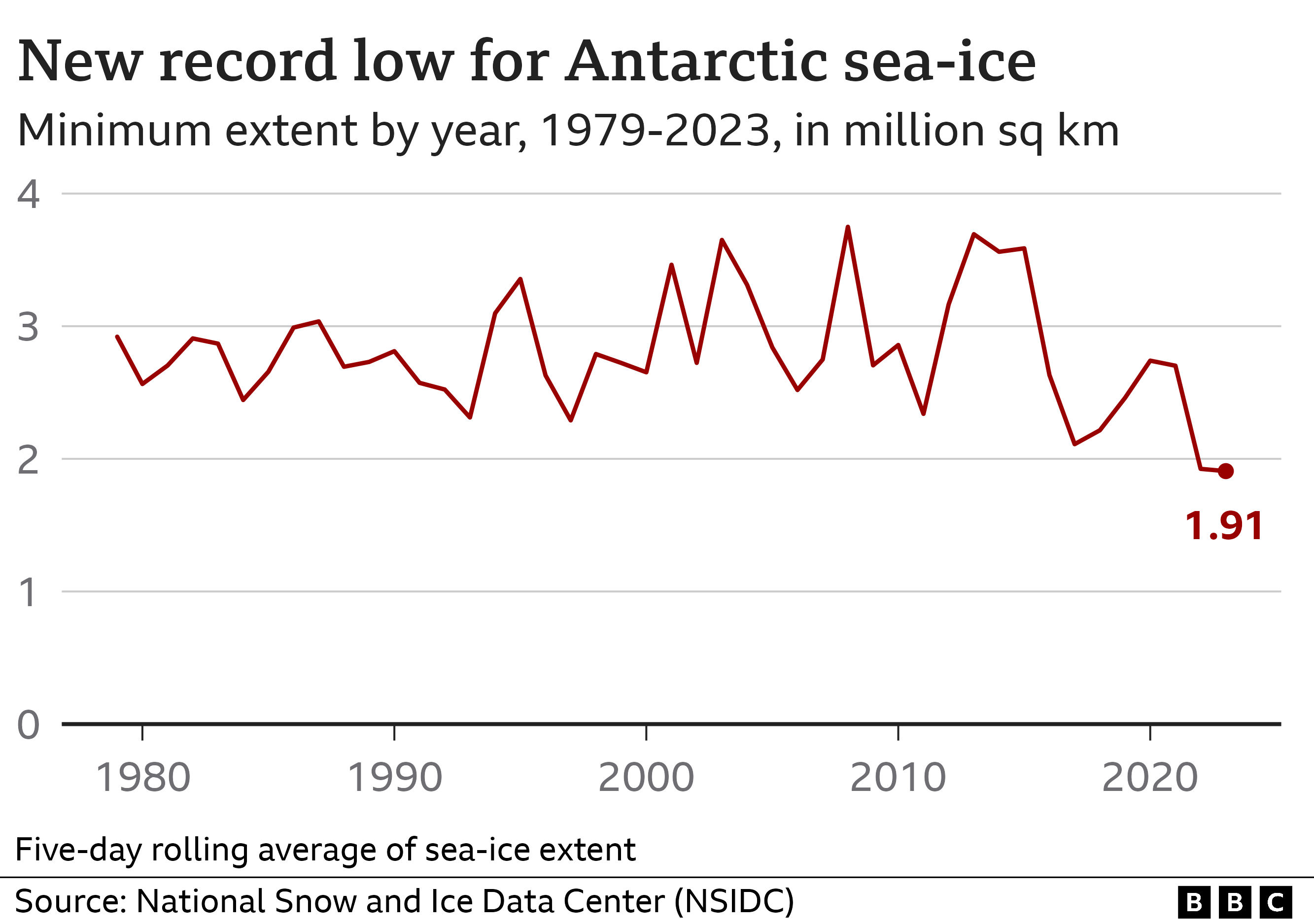
Computer models had predicted that it would show long-term decline, much like we have seen in the Arctic, where summer sea-ice extent has been shrinking by 12-13% per decade as a result of global warming.
But the Antarctic hasn't behaved like that.
Data sources other than satellites allow us to look back at least as far as 1900.
These indicate Antarctic sea-ice was in a state of decline early in the last century, but then started to increase.
Recently it has shown great variability, with record satellite winter maximums and now record satellite summer minimums as well.
In winter, the floes can cover 18 million sq km (6.9 million sq miles), and more.
How much ice is a million sq km?
It's broadly what this year's summer ice pack is missing compared with the longer-term average. That's enough to cover the British isles.
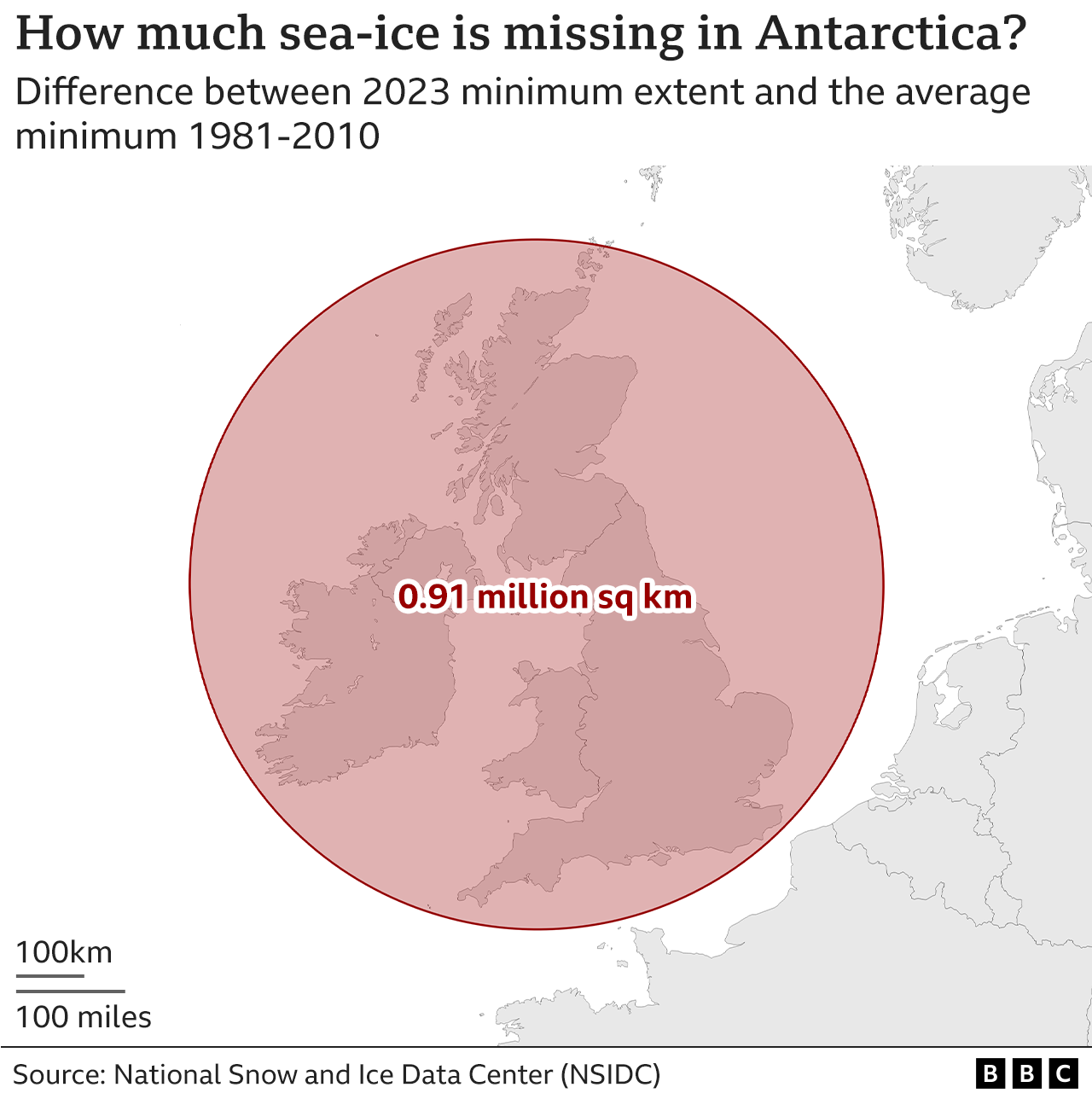
It will start growing again very soon and it's important that it does… for a host of reasons.
Freezing seawater at the surface of the ocean expels salt, making the water below denser, causing it to sink.
This is part of the engine that drives the great ocean conveyor - the mass movement of water that helps regulate energy in the climate system.
Sea-ice is also hugely important for life at the poles.
In the Antarctic, the algae that cling to the ice are a source of food for the small crustaceans known as krill, which are a basic food resource for whales, seals, penguins and other birds.
The sea-ice is also a platform on which some species will haul out and rest.
Warm air increasing melt
It's likely this year's record sea-ice minimum has been influenced by the unusually high air temperatures to the west and east of the Antarctic Peninsula.
These have been 1.5C above the long-term average.
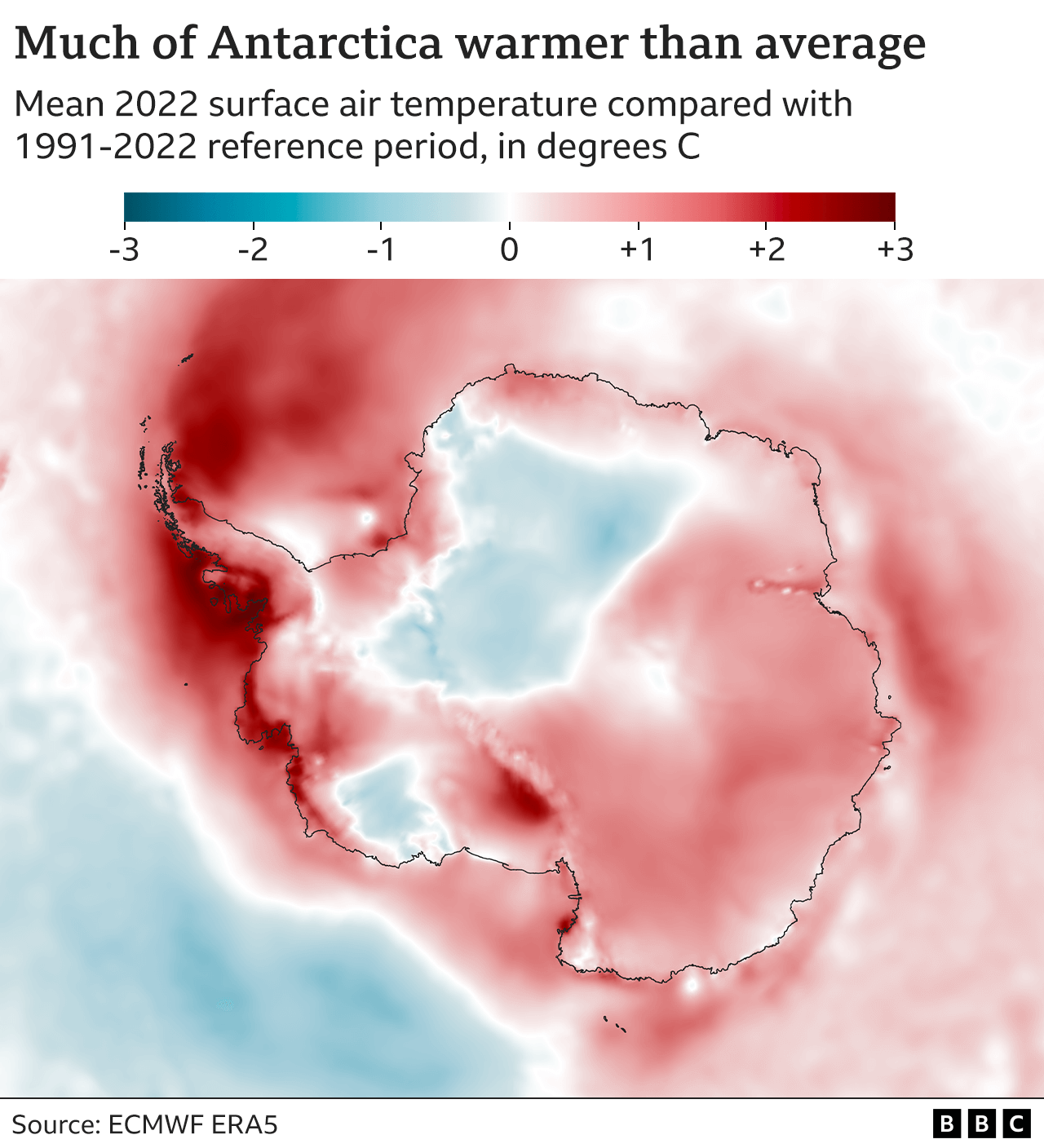
There's also something called the Southern Annular Mode (SAM), which is a key player in the region.
It describes variations in atmospheric pressure around Antarctica which in turn influence the continent's famous encircling westerly winds.
The mode is said to be in a strongly positive phase at the moment.
This strengthens the prevailing westerlies and drags them poleward.
Increased storminess helps to break up floes and push them north into warmer waters to melt out.
Researchers think the more positive trends seen in the SAM over the longer term are probably linked to the presence of an ozone hole over Antarctica and the rise of greenhouse gases in the atmosphere.
How does this compare to Arctic ice melt?
It's important to understand the differences between the poles.
The Arctic is an ocean hemmed in by continents. The Antarctic is a continent surrounded by ocean.
The divergence in geography means ice growth in winter in the Antarctic is much less constrained. The floes can develop as far north as conditions will allow.
But the geography also means summer warmth can chase the sea-ice all the way back to the Antarctic coastline in many places.
And because the Antarctic has difficulty retaining ice from year to year, its floes are thinner than in the Arctic - generally just one metre or less, versus 3-4m for long-lived ice in the polar north.
-
The River Wye is dying , being destroyed by pollution resulting from the intensification of agriculture and release of sewage . Increasing...
-
According to leading Scientists the chances of saving the planet now is most unlikely!! But don't panic it's only your children and...
-
Youth Demand have organised this event at The Fold, Organic Farm, Bransford, Worcester. I'm going along top see whats happening and mee...






